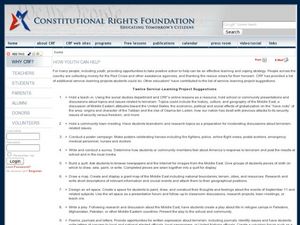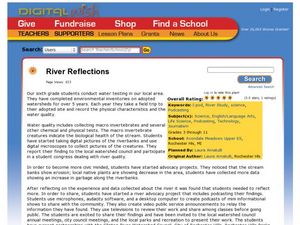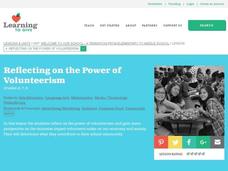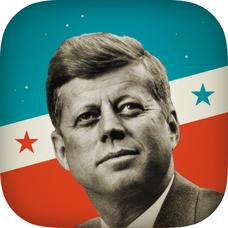Curated OER
Give and Take
Second graders are introduced to the differences between goods and services. In groups, they discover whether a given occupation offers a good, service or both. To end the lesson, they pick one occupation that interest them, draws a...
Curated OER
A Straightforward Approach
Students explore the concept of philanthropy. In this character education lesson, students discuss the value of honesty and consider honesty towards self, family, friends, and the community as they write a reflection.
Curated OER
Disaster Relief - You Can Count On Me!
Students practice stewardship. In this service learning instructional activity, students respond to those in need after a natural disaster as they investigate philanthropy.
Teach Engineering
Engineers Love Pizza, Too!
Help overcome challenges in eating pizza. Scholars work in groups to design a device that assists a physically handicapped person eat pizza. They build a prototype of such a device to test their designs before building. To...
Penguin Books
A Teacher's Guide to the Signet Classic Edition of Edith Wharton's Ethan Frome
Is it possible to have too much concern for others? Can we be trapped by our expectations as well as those of society? Edith Wharton's chilling tale of Ethan Frome asks these and other disquieting questions. Signet's guide to Ethan Frome...
Curated OER
Health Services in the Community
The students will learn about and do research on health care workers. In this lesson students learn about community health care workers through doing research. Their final work is then collated to make a class book.
Curated OER
Does It Looks All Right to Me?
Students explore the concept of philanthropy. In this service learning instructional activity, students examine the accomplishments of Civil Rights leaders' as works of philanthropy. Students read literature regarding diversity and study...
Curated OER
America Responds to Terrorism: How Youth Can Help
Students explore the opportunity to educate others. For this response to terrorism lesson, students explore 12 service learning opportunities that they may choose to implement in order to take positive action in response to terrorism.
Curated OER
Promoting the Common Good
Students participate in a service learning activity regarding universal human rights. In this service learning lesson, students craft posters that illustrate guaranteed rights that all people should possess.
Curated OER
River Reflections
Sixth graders create podcasts and video public service announcements. In this environmental advocacy lesson, 6th graders study the local watershed and become advocates for their local environment. In the process, they create podcasts and...
Curated OER
No Food, No Money, No Job: What to Do?
Students explore the concept of philanthropy. In this service learning lesson, students research the Civilian Conservation Corps and create an advertisement that might have promoted it.
Curated OER
Reflecting on the Power of Volunteerism
Students explore the concept of philanthropy. In this service learning lesson, students contribute to society by examining volunteer activities that benefit others. Students collaborate to create a skit to promote volunteerism.
Curated OER
Making a Connection
Learners research why government community workers are important to us. They work in teams to identify and illustrate the jobs and services provided by these community workers. Assessment comes from their Student Concept Maps.
Curated OER
What Is a Foundation?
Students explore the concept of grants. In this philanthropy instructional activity, students meet a grant-writer and then collaborate to prepare a grant request.
Curated OER
Hazardous Chemicals? Not in my Water!
Students reflect on the effects of their actions on the environment. In this community service instructional activity, students investigate the hazardous quality of products within their homes. Student educate their families and...
Curated OER
What's Public? What's Private?
Young scholars explore the difference between public and private, and will categorize a list of places as public or private. They determine what is their responsibility to care for public (common) areas and share their new understanding...
Curated OER
The Important Thing About Reading
Third through fifth graders discover the importance of reading and plan a service project to provide books to children. First, they read the book The Important Book and then they brainstorm about the importance of reading. Afterward,...
John F. Kennedy Library Foundation
JFK Challenge
And so, my fellow Americans: ask not what your country can do for you—ask what you can do for your country. And so begins your invigorating, innovative learning experience in the JFK Challenge app! Learners...
Curated OER
4-H Food Science- Intermediate Activity
In this nutrition worksheet set, students complete a dinner detective nutrient fill in the blank, a food safety true or false page, and plan a picnic with food safety rules in mind. They investigate careers that involve food safety.
Curated OER
What Is a Watershed?
Middle schoolers explore the concept of water pollution. In this environmental stewardship instructional activity, students discover what watersheds are and consider how to protect them.
Curated OER
Helping Ourselves: Why Philanthropy Works
Young scholars discover the concept of philanthropy. In this civics activity, students investigate the role of philanthropy in our society, and how it makes life better for all.
Curated OER
Writing a Personal Narrative
What is the difference between a news story and a personal narrative? This plan has learners write a personal narrative using the topic of service projects in their community. Consider completing a cross-curricular extension by bringing...
Curated OER
Community Service Through Art: Empty Bowls
Fifth graders become more aware of the worldwide poverty issues. Through reading books, they can get a feeling for what the daily life of a person who lives in poverty is like. The research skills studied can be used in different subjects.
Curated OER
Mapping Human Rights in Our Community
Learners work in groups to draw a map of their town or neighborhood. They include their homes, major public buildings and places. Students analyze their maps from a human rights perspective.























